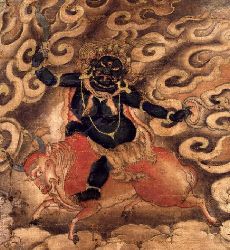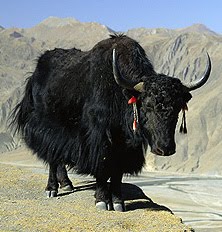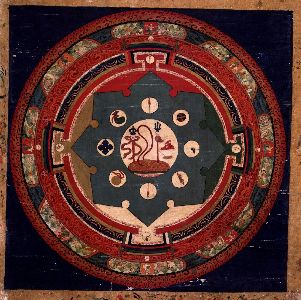
Magzor Gyalmo, meaning
the Queen who Repels Armies, or
the Queen who has the power to turn back armies, belongs to the larger class of enlightened protector deities known as
Shri Devi, or Palden Lhamo in Tibetan. Magzor Gyalmo is a wrathful emanation of the peaceful goddess Sarasvati, popular in both Hinduism and Buddhism.
Shri Devi is understood as a class of female protectors. Some say that there are twenty-one forms of Shri Devi, often including the Bon protector
Sipai Gyalmo as one of the forms. Not all forms of Shri Devi have the same entity. The principal form of the protector, Dudsolma or Dudmo Remati, appearing with one face and four arms, riding a donkey, is a wrathful manifestation of Shri Lakshmi. Magzor Gyalmo with two arms, riding a mule, is a manifestation of Sarasvati. In the Bon Religion Sipai Gyalmo is the wrathful form of Satrig Ersang, one of the four principal deities/gods of the Bon Religion.
Magzor Gyalmo, often shortened to Magzorma, was first popularized in Tibet by the Zhang, Mu and Sakya family lineages. This form of Shri Devi was likely indigenous to Tibet and the result of a
pure vision (dag nang) or a
revealed treasure (terma) discovery. It later entered the Gelug School through the family tradition of either the 1st or the 2nd Dalai Lama (see possibly the earliest
Gelug painting). Again at the time of the 5th Dalai Lama in the 17th century it became the special protector of the Dalai Lama incarnation tradition and of the Ganden Podrang Government of Tibet.
The majority of Magzor Gyalmo paintings and sculpture on the HAR website were created for Gelug practitioners and institutions in Tibet, Mongolia and China. Of the nearly 100 objects on the site only three paintings can be identified as belonging to the Sakya Tradition. All of the others are Gelug in origin. How do we know?
There are two ways to distinguish between Sakya and Gelug forms of Magzor Gyalmo. With paintings, inspecting the over-all composition, the minor figures surrounding the central Magzor Gyalmo must be looked at carefully. [1] It is most often the case that Lama Tsongkapa, founder of the Gelug Tradition, wearing a yellow hat, will be placed at the top center, and if not there then somewhere else along the top of the painting. [2] In the texts describing the iconography of Magzorma, for the Gelug, she has a snow lion as an earring for the right ear and a coiled snake for the left earring. In the Sakya Tradition this iconographic detail is reversed. Don't believe us? Look for yourself:
Gelug Example,
Sakya Example.
Because Magzorma is the wrathful form of Sarasvati and because Sarasvati is the goddess of learning and eloquence, then it follows that she is related to and paired with the bodhisattva of wisdom - Manjushri. However, it would not be proper to have the peaceful appearance of Manjushri associated with the wrathful appearance of Magzorma. So, with all of that said, Magzorma is most commonly associated with the wrathful forms of Manjushri: Heruka
Vajrabhairava,
Rakta Yamari or
Krishna Yamari. These three are the most wrathful forms of Manjushri. They are also meditational deities of the
Anuttarayoga Classification of Tantra. It is very common to find one of these three wrathful figures of Manjushri at the top of a Magzorma painting. Sakya paintings generally portray Rakta Yamari at the top along with one or two Lama figures, and often
Ngorchen Kunga Zangpo, wearing a red pandita hat.
In the Tantra narrating the history of Magzorma she is described as the servant or younger sister of Shri Devi (with four arms). Aside from functioning as a protector deity in the Sakya and Gelug Traditions of Tibetan Buddhism, Magzor Gyalmo is used extensively in the ritual of
divination - generally using dice or prayer beads.
The textual source for Magzor Gyalmo is the
Dakinyagnijihajvala Tantra, Dege Kanjur, volume 98, pp.223-253. It is found in the Nyingma Tantra section, vol.3.












